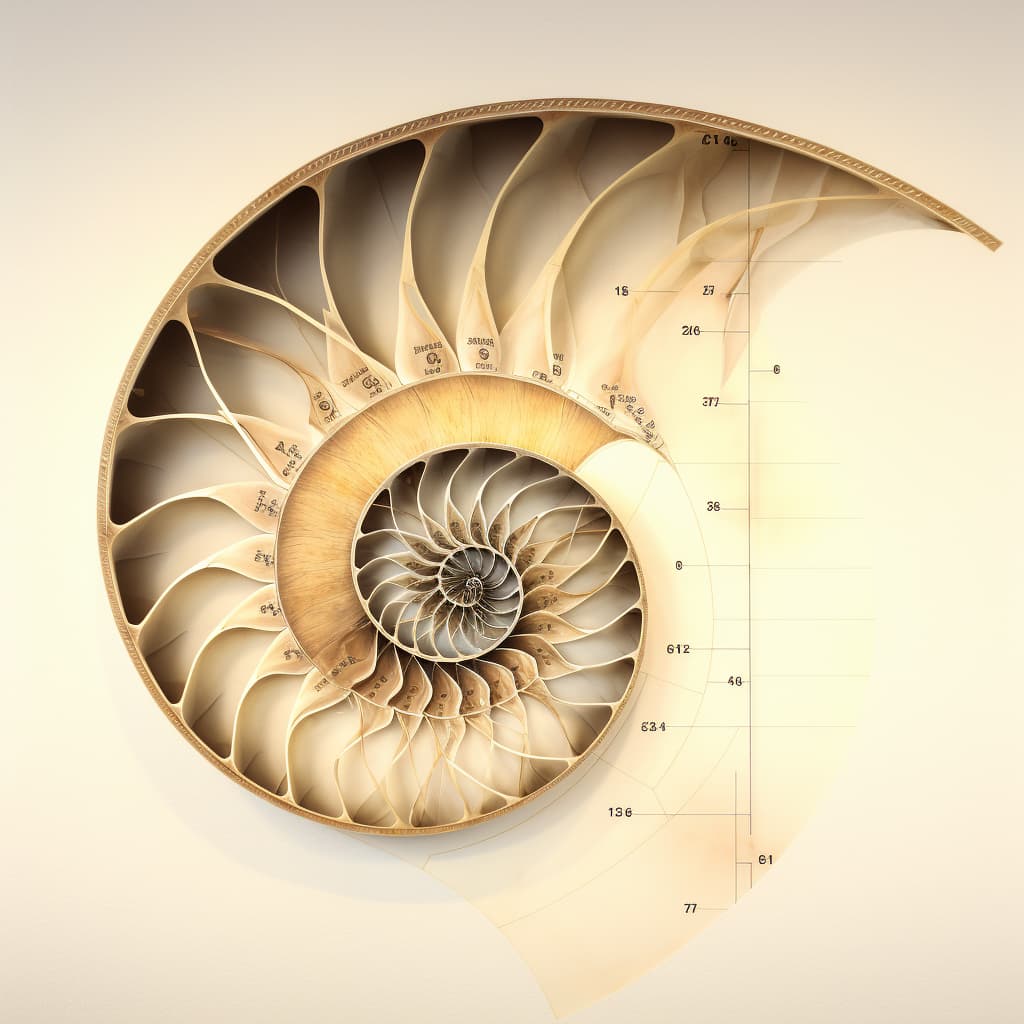AI generated content
This content is generated by an AI and does not reflect the opinions or views of individuals, either living or deceased.
| Text generated by | ChatGPT (GPT-4) |
| Text prompt | Write a blog post about the golden ratio |
| Image generated by | Midjourney |
| Image prompt | The Golden Ratio |
The Golden Ratio: The Mathematics of Beauty and Harmony

The realm of mathematics, often seen as a landscape of abstract concepts, holds a number of extraordinary phenomena that bridge the gap between the quantitative and qualitative aspects of our world. One such concept is the Golden Ratio, a mathematical relationship imbued with aesthetic appeal that has been cherished by artists, architects, and nature itself. It's a tale of mathematics, art, and beauty, intertwined in an elegant ratio, often symbolized by the Greek letter φ (Phi).
What is the Golden Ratio?
The Golden Ratio, approximately 1.61803398875, is derived from the division of a line into two parts such that the ratio of the whole line to the longer segment is equal to the ratio of the longer segment to the shorter one. This intriguing proportion, described by the equation (a+b)/a = a/b = φ, was first recorded in Euclid's Elements as the "extreme and mean ratio."
The Golden Ratio in the Ancient World
The allure of the Golden Ratio can be traced back to antiquity. The ancient Greeks, renowned for their pursuit of beauty and harmony, recognized the pleasing aesthetics of this ratio. They incorporated it into their architecture and art, most notably in the design of the Parthenon.
Moreover, the famous Fibonacci sequence, where each number is the sum of the two preceding ones (0, 1, 1, 2, 3, 5, 8, 13, ...), is closely tied to the Golden Ratio. As the numbers increase, the ratio between two consecutive numbers tends towards the Golden Ratio, a phenomenon known to Leonardo Fibonacci himself when he introduced the sequence to Western mathematics in the 13th century.
The Golden Ratio and Nature
The Fibonacci sequence, and by extension the Golden Ratio, exhibits a stunning presence in nature. From the spiral arrangement of seeds in a sunflower, the scales on a pinecone, the swirl of a seashell, to the spiraling galaxies, the fingerprint of the Golden Ratio is everywhere in the natural world.
Scientists believe this widespread occurrence is due to the efficiency the Golden Ratio offers in growth processes and packing problems, whether it's maximizing sunlight exposure for leaves or space utilization in seed arrangements. The Golden Ratio, in essence, is a manifestation of nature's inherent propensity for efficient design.
The Golden Ratio in Art and Architecture
Artists and architects throughout history have harnessed the appeal of the Golden Ratio to create aesthetically pleasing designs. The Renaissance masters, including Leonardo da Vinci and Albrecht Dürer, used the Golden Ratio in their works, believing it created a balanced, harmonious composition.
In architecture, Le Corbusier, the pioneer of modern architecture, developed the Modulor, a system of proportions based on the Golden Ratio, to determine the scale of architectural elements. The Golden Ratio can also be seen in iconic structures like the Great Pyramid of Giza, the Parthenon, and even in modern designs such as the United Nations Headquarters in New York.
The Golden Ratio Today
Today, the Golden Ratio continues to permeate various fields. In graphic design, it's used to establish harmonious layouts. In photography, the "rule of thirds"—which aligns with the Golden Ratio—helps create balanced compositions. Even in finance, traders use Fibonacci retracements, based on the Golden Ratio, to predict future market movements.
Moreover, the Golden Ratio has been found to be aesthetically pleasing in human faces and bodies, and it's often used as a standard in cosmetic surgery and dental aesthetics.
The Controversy of the Golden Ratio
While the Golden Ratio is often touted as the mathematical secret of beauty, it is important to note that its usage and significance are subjects of debate. Many claims about the presence of the Golden Ratio in historical works of art and architecture are anecdotal and lack solid empirical evidence. Similarly, while certain natural phenomena align with the Golden Ratio, it is not a universal pattern.
The notion that the Golden Ratio has universal aesthetic appeal is also challenged. Beauty and aesthetics are complex, influenced by a multitude of factors beyond simple mathematical relationships. Cultural, historical, and personal contexts play crucial roles in determining what is considered beautiful or aesthetically pleasing.
The Golden Ratio in the Digital Age
In today's digital era, the Golden Ratio continues to be a tool for creating aesthetically pleasing designs. Web developers and digital designers often use it to create harmonious page layouts, logos, and user interfaces. The Golden Ratio helps provide a sense of natural balance and cohesion, improving the user experience.
Conclusion: The Universal Appeal of the Golden Ratio
Despite controversies, the Golden Ratio endures as a symbol of the fascinating intersection between mathematics, nature, and aesthetics. The very fact that a simple mathematical ratio can generate such intrigue and beauty is a testament to the power and mystery of mathematics.
From the spiral of a galaxy to the layout of a webpage, from the pyramids of Giza to the proportions of a Renaissance painting, the Golden Ratio continues to captivate our imagination. It stands as a testament to the inherent elegance of mathematics, the pursuit of harmony, and our perpetual quest to find and create beauty in the world around us.
In conclusion, whether you're a mathematician decoding the patterns of the universe, an artist striving to create a masterpiece, or just someone appreciating the beauty of a sunflower, the Golden Ratio is a reminder of the sublime elegance and intricate connections present in our world. It invites us to see the universe through a mathematical lens and to appreciate the art in equations and the numbers in nature. So, the next time you marvel at a piece of art or the symphony of nature, remember the Golden Ratio, the silent maestro conducting the orchestra of beauty and harmony.
